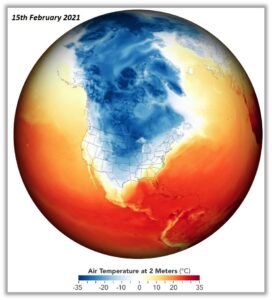Lead Supervisor: Kevin Hodges, Department of Meteorology, University of Reading and National Centre for Atmospheric Science
Email: k.i.hodges@reading.ac.uk
Co-supervisors: Andrew Charlton-Perez, Department of Meteorology, University of Reading; Alec Vessey, AXA XL
Extreme cold weather devastated the United States (U.S.) in February 2021 (Figure 1) and December 2022. The Feb. 2021 event was among the costliest hazards to occur globally in 2021 for the insurance industry (Insurance Information Institute, 2022). The unprecedented Feb. 2021 event caused US$ 26bn in economic damaged, greatly surpassing the previous most costly severe winter weather event in 1993 (US $12bn) (NOAA, 2023). At the time, the event was widely reported in the media as ‘Storm Uri’ (e.g., Independent, 2021; Mail Online, 2021, The Weather Channel, 2021), but meteorological conditions during this event did not indicate the presence of a low-pressure storm. Instead, the devastation was caused by a Cold Air Outbreak (CAO), where cold air originating in Canada progressed southward over the U.S., reaching the most southern states such as Texas. This caused widespread power outages, business interruption, damage, and fatalities across the U.S., especially in southern states e.g., Texas, which are not regularly exposed to such temperature extremes.

Figure 1. Air temperatures 2 meters above the ground on February 15th 2021, during the February 2021 Cold Air Outbreak. Source: NASA (2023)
Extra-tropical storms and CAOs are the main drivers of economic and insured losses in the U.S. during wintertime. These events are collectively combined in the insurance industry as ‘U.S. Winterstorms’, which describes any event that causes damage by wind, freeze, ice, and snow. However, in scientific literature, these hazards are often reported upon separately as they are distinct meteorological phenomenon. This PhD project seeks to ascertain the collective risk of ‘U.S. Winterstorms’ in the present-day and future climate using a newly developed CAO tracking algorithm, whilst also advancing the understanding of U.S. extratropical storms, CAOs and extreme winter weather.
This project has three core research objectives:
- Determine the collective present-day risk of extreme U.S. winter weather, i.e., extratropical storms and CAOs, and determine the sensitivity to various methods used to identify such hazards in historical datasets.
- Determine how ‘extreme’ the Feb. 2021 U.S. Cold Air Outbreak was and examine how this and other extreme U.S. winter weather events developed.
- Determine how the frequency and severity of extreme U.S. winter weather may change in a future climate in response to climate change.
Training Opportunities
The PhD student will also work closely with AXA XL, the world’s largest (re)insurer, to train in the application of Catastrophe modeling. The successful student will spend a 3-month secondment within AXA XL’s Science and Natural Perils Team, in London, to develop skills in risk analysis within a business setting.
They will also benefit from the rich experience of the well-established researchers, as part of the supervisory team and other research groups at the University. The student will be encouraged to attend academic conferences and workshops in both the UK and internationally. Training for writing scientific and public-oriented publications will also be provided.
Student Profile
This project will be suitable for a numerate, enthusiastic, and motivated student, with an interest in furthering our scientific understanding of U.S. Cold Air Outbreaks (CAO) and how risk is quantified/considered within the (re)insurance industry. A degree involving a substantial level of numeracy would be beneficial, such as physics, mathematics, engineering, or a related environmental or physical science. Some experience of using Linux and programming software would be beneficial, or a willingness and drive to learn these skills.
Funding Particulars
This project has CASE support from AXA XL

